上海教育出版社牛津英语4A教案(Unit1)
- 格式:doc
- 大小:76.50 KB
- 文档页数:8
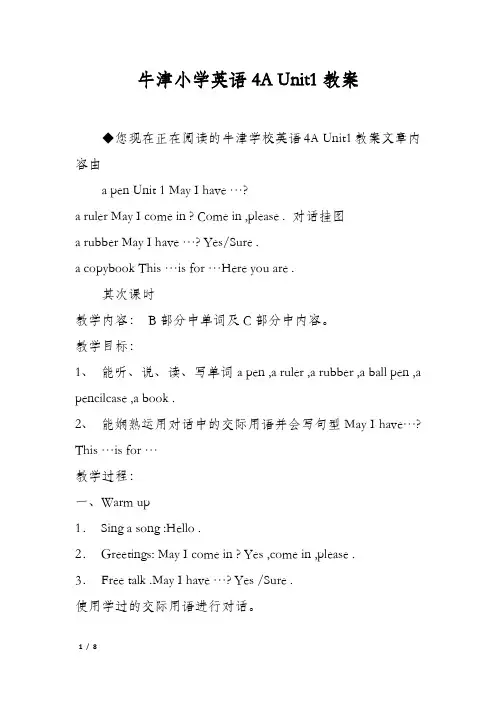
牛津小学英语4A Unit1教案◆您现在正在阅读的牛津学校英语4A Unit1教案文章内容由a pen Unit 1 May I have …?a ruler May I come in ? Come in ,please . 对话挂图a rubber May I have …? Yes/Sure .a copybook This …is for …Here you are .其次课时教学内容:B部分中单词及C部分中内容。
教学目标:1、能听、说、读、写单词a pen ,a ruler ,a rubber ,a ball pen ,a pencilcase ,a book .2、能娴熟运用对话中的交际用语并会写句型May I have…? This …is for …教学过程:一、Warm up1.Sing a song :Hello .2.Greetings: May I come in ? Yes ,come in ,please .3.Free talk .May I have …? Yes /Sure .使用学过的交际用语进行对话。
二、Revision .同学用自己的实物表演Read and say中的对话。
1.师引导同学对话。
2.同学之间交际练习。
三、Presentation and practice .1.学习单词a ball pen ,a pencil case ,a brush , a bookmark ,a notebook ,a book .(1)利用实物学习单词: a pencil case .T: What’s this in English ? Oh ,It’s a pencil case . Do you like pencil case ?S: Yes . 听录音,生跟读。
(2)同法学习单词a bookmark ,a brush ,a notebook .2.Play a game : What’s missing ?嬉戏规章:将a bookmark ,a brush ,a notebook ,a pencil case的图片贴在黑板上,让一同学背对黑板,师拿掉任一张图,让同学猜出缺少的那张图片。
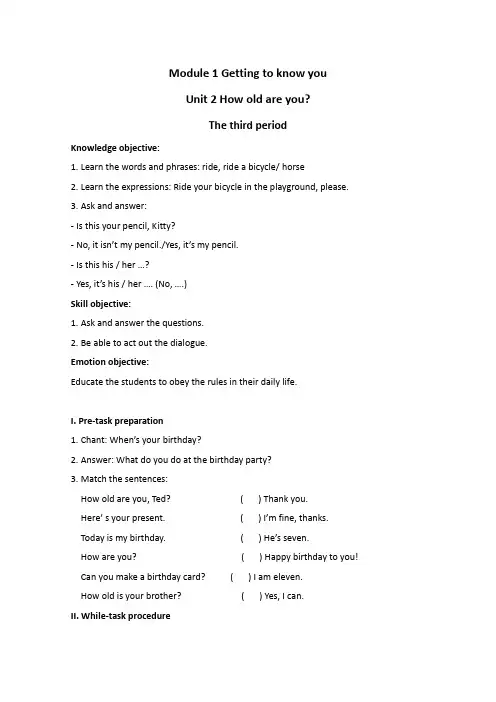
Module 1 Getting to know youUnit 2 How old are you?The third periodKnowledge objective:1. Learn the words and phrases: ride, ride a bicycle/ horse2. Learn the expressions: Ride your bicycle in the playground, please.3. Ask and answer:- Is this your pencil, Kitty?- No, it isn’t my pencil./Yes, it’s my pencil.- Is this his / her …?- Yes, it’s his / her …. (No, ….)Skill objective:1. Ask and answer the questions.2. Be able to act out the dialogue.Emotion objective:Educate the students to obey the rules in their daily life.I. Pre-task preparation1. Chant: When’s your birthday?2. Answer: What do you do at the birthday party?3. Match the sentences:How old are you, Ted? ( ) Thank you.Here’ s your present. ( ) I’m fine, thanks. Today is my birthday. ( ) He’s seven.How are you? ( ) Happy birthday to you! Can you make a birthday card? ( ) I am eleven.How old is your brother? ( ) Yes, I can.II. While-task procedure(一) Text:1. Read and judge:( ) 1. The boy’s name is Ben Li.( ) 2. Ben is ten.( ) 3. This is Ben’s bicycle.( ) 4. He is riding a horse now.( ) 5. The policeman suggests Ben to ride the bicycle in the playground.2. Learn the phrases: ride a bicycle/ bike; ride a horse3. Read the text after the tape4. Read the text together5. Act out the text6. T: If you’re the policeman, what would you say to Ben?(Ride y our bicycle in the park/ …OR: Don’t ride the bicycle. Because you’re too young.)(二) Sentence patterns:1. Read and practice:-- Is this your pencil, Kitty?-- Yes, it’s my pencil. (No, it isn’t my pencil.)(bicycle / Eddie; milk / Wendy; card / Ginger)2. Read and practice:-- Is this his rubber?-- No, it isn’t his rubber.-- Is this her rubber,?-- Yes, it’s her rubber.(desk yo yo telephone toy dog skateboard)III. Post-task activity1. Aaswer the question:1) Is this your car? (yes)2) Is that his ball? (no)3) Is this her blouse? (yes)4) Is this Tom’s parrot? (yes)5) Is that your sister’s bag? (no)2. Read and complete the dialogue:-- Excuse me!-- Yes?-- Is this your schoolbag?-- No, it isn’t. It’s Tom’s schoolbag. Tom’s schoolbag is black. -- Tom! Is this your schoolbag?-- Yes, it is.-- Here you are.-- Thank you.3. Act out the dialogue in the groups of three.IV. Homework1. Listen and read on Page 7.2. Copy the words and the text.3. Act out the dialogue.。
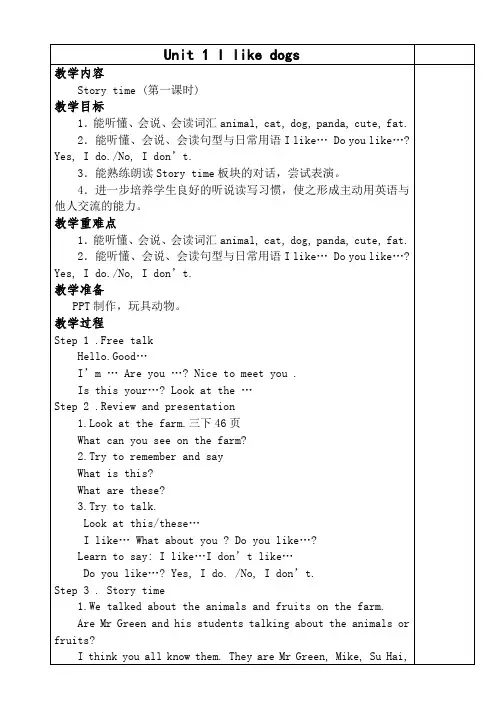
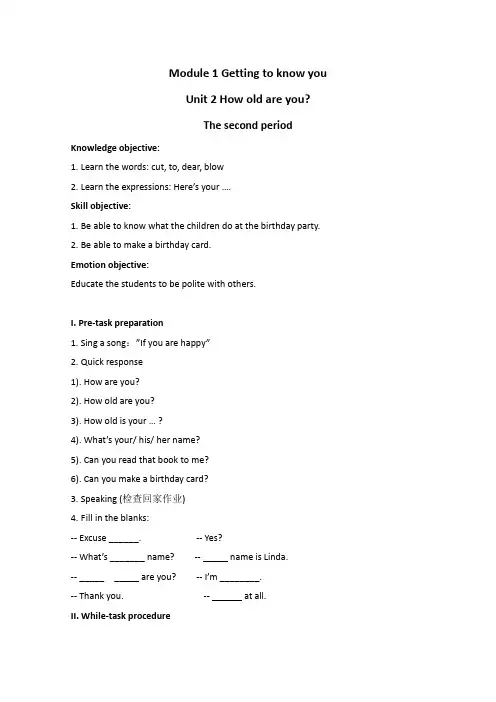
Module 1 Getting to know youUnit 2 How old are you?The second period Knowledge objective:1. Learn the words: cut, to, dear, blow2. Learn the expressions: Here’s your ….Skill objective:1. Be able to know what the children do at the birthday party.2. Be able to make a birthday card.Emotion objective:Educate the students to be polite with others.I. Pre-task preparation1. Sing a song:”If you are happy”2. Quick response1). How are you?2). How old are you?3). How old is your … ?4). What’s your/ his/ her name?5). Can you read that book to me?6). Can you make a birthday card?3. Speaking (检查回家作业)4. Fill in the blanks:-- Excuse ______. -- Yes?-- What’s _______ name? -- _____ name is Linda.-- _____ _____ are you? -- I’m ________.-- Thank you. -- ______ at all.II. While-task procedure(一) Words:1. Listen and spellsnow show slow blownear fear tear dear2. Explain and practice:dear: dear Mum/ mother; dear Dad/ mather dear Kitty; dear children blow: blow the candle The wind blows and blows.cut: cut the cake; cut the paper; cut the grass; cut the apple(二) Sentence pattern:1. Read the sentences: -- Here’s your cake.-- Thank you.2. Substitution drills:sweet paint ruler dress coat umbrella(三) Text:1. Listen to the text and answer: Whose birthday is today?(Sing the song with the tape.)2. Read the text.3. T: What do you do at the birthday party?Discuss and learn to say:make a wish; blow out candles; sing a birthday song; eat birthday cakel;sing a birthday song; play computer games; open presents4. Let’s chant (Cambrige English):Birthday, birthday, when’s your birthday?Not today, not today, my birthda y isn’t today.Whose birthday is it today?It’s Sam’s birthday. It’s Sam’s birthday.Birthday, birthday, when’s your birthday?It’s today. It’s today. Today’s my birthday.Happy birthday! Happy birthday!Thank you very much. Let’s eat the birthday cake.Le t’s eat the birthday cake.(四) Make a birthday card:1. Fold the card.2. Draw a picture on the card.3. Write: Dear AliceHappy Birthday!From KittyIII. Post-task activity1. Listen and fill in the blanks:Today’s Peter’s birthday. He’s in the garden with his parents. They’re having a birthday party. Bill and Tom are there, too. Now they’re eating the cake. Peter is opening his present. He is very happy.2. Read the passage.IV. Homework1. Read the text.2. Copy the words and text.3. Make a birthday card.。

牛津英语4A——Unit1MayIhave…四年级英语教案教学内容: b部分中单词以及c部分中重点句型教学目的、教学重点:1、能听得懂、会说、会读和会拼写单词:a pen, a ruler,a rubbera book 、a ball pen,a pencil case,a bookmark.2、能听懂、会说、会读、会写句型:may i have…? sure,here you are.教具准备:录音机、磁带、实物、教学过程:一、 warm up1、free talk.2、chant: one ,two,three,turn around;one ,two,three,reach up high;one ,two,three, bend down low;one ,two,three,show me your book;one ,two,three,show me your pen;one ,two,three,show me your ruler;one ,two,three,show me your rubber;one ,two,three,where are they?they are in our bag.二、 presentation and practice.a、words1、t:today i am very happy.because,i have a new bag.look!it’s very nice.i like it very much. but,what’s in my bag?who can guess?(相机简笔一只面带笑容的书包)(the bag is very happy,too.she has many lovely babies,)2、s(answer)3、t:let me see,yes/no,there is a……how to spell?followhim/her,please!(把学生猜到的文具随机递给学生)3、出示单词卡,集体读已学单词。
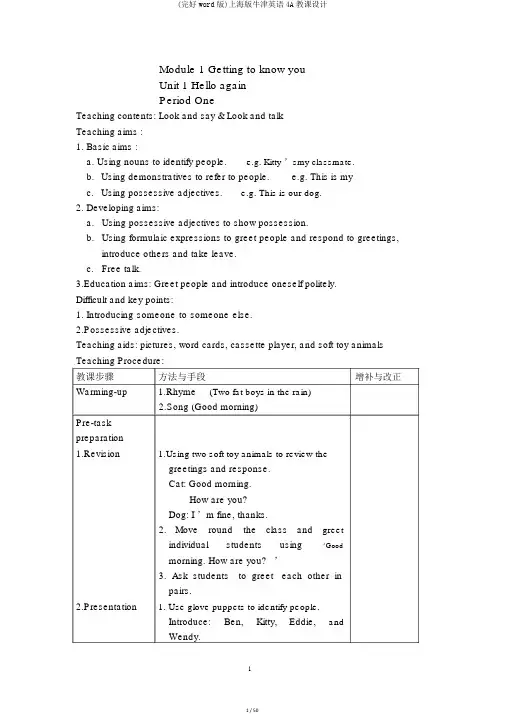
Module 1 Getting to know youUnit 1 Hello againPeriod OneTeaching contents: Look and say & Look and talkTeaching aims :1. Basic aims :a. Using nouns to identify people. e.g. Kitty ’smy classmate.b. Using demonstratives to refer to people. e.g. This is myc. Using possessive adjectives. e.g. This is our dog.2.Developing aims:ing possessive adjectives to show possession.ing formulaic expressions to greet people and respond to greetings,introduce others and take leave.c.Free talk.cation aims: Greet people and introduce oneself politely.Difficult and key points:1.Introducing someone to someone else.2.Possessive adjectives.Teaching aids: pictures, word cards, cassette player, and soft toy animals Teaching Procedure:教课步骤方法与手段增补与改正Warming-up 1.Rhyme(Two fat boys in the rain)2.Song (Good morning)Pre-taskpreparation1.Revision ing two soft toy animals to review thegreetings and response.Cat: Good morning.How are you?Dog: I ’m fine, thanks.2. Move round the class and greetindividual students using‘Goodmorning. How are you?’3. Ask students to greet each other inpairs.2.Presentation 1. Use glove puppets to identify people.Introduce: Ben, Kitty, Eddie,andWendy.2. Guess: Who is Wendy?to elicit: She ’sEddie ’ssister.While-taskprocedure1.Introduce: 1. Invite one student to stand up. Say:classmate He/She is your classmate. You ’reclassmates.2. Imitation(Show the word card) Ask students toread the word several times.3. Invite a different student to stand up.Ask: What ’shis/her name? Prompt thestudents to say: This is my classmate.His/Her name ’s ___.4. Substitution:In groups of four, have studentsintroduce their classmates.2.Introduce:our 1. Show the toy dog. Ask: Whose dog isthis? to elicit: It ’sKitty and Ben ’sdog.2. Play the cassette: This is our dog. Hisname ’sSam.3. Imitation:a. Show the word card. Ask students toread the word.b. Play the cassette again. Thestudents listen and repeat.4. Sentence making: e.g. This is ourfriend/classmate/teacher. His/Hername ’s___.3. Listen and 1. Play the cassette: Look and say. The answer students listen carefully.2.Answer the questions:Who ’sEddie ’sclassmate?Who ’sWendy?Whose cat is this?What ’sthe cat ’sname?3.Play the cassette again.The students listen and repeat.Post-taskactivities1. Production1. In groups of four, have the studentspractice the dialogue.2. Play a game (Look and talk)a. Write the numbers on the back ofthe word card.b. Students choose the differentnumbers.c. Then ask students to complete thedialogue according to their cards.3. Free talkEncourage students to introduce theirpets, their classmates using their ownname and their toy animals.2. Assignment 1. Introduce your parents using ‘This isHis/Her name ’s2.Write about one of your classmates.成功经验课板后书随设思虑与对策笔计Period TwoTeaching contents: Read a story & Learn the soundTeaching Aims:1.Basic aims:ing verbs to describe actions. e.g. run, swim, jumping modals to talk about ability. e.g. She can run.c. Using connectives to link contrasting ideas e.g. But she can’tcook.d.Saying the sound ‘ch- ‘2.Developing aims:a.Read and act the storyb.Talking about ability.c. Write a simple story.Teaching aids: pictures, word cards, cassette player, and mask Teaching Procedure:教课步骤方法与手段增补与改正Warming-up Song (I can sing)Pre-taskpreparation1. Revision 1. Say and act: sing, draw, write2. Sentence making:e.g. I can draw a dog.I can sing a song.2. Presentation 1. Put on the mask. Ask: Do youknow him? to elicit: He is aSuperman.2. Encourage students to describeSuperman.e.g. He’s strong. He’sbrave/super.While-taskprocedure1.Introduce: 1. Ask students to guess whatrun, jump, Superman can do.swim, dive, 2. Put the word and picture cards onfly the board in random order. Usingmine, introduce: run, swim, jump,dive, and fly.3. Read the words with actions.4. Invite individual students to comeout and match the words andpictures.5. Invite students to say whatSuperman can do.e.g. He can run. He can dive.2.Introduce: 1. Ask students what they thinkcook, Superman can ’tdo.2. Using mime, introduce: cook3. Introduce: Superman can fly. Buthe can ’tcook.4.Sentence making:e.g. I can sing. But I can’tfly.3.Read the 1.Ask: Do you like Superman?story to elicit: Alice likes Supergirl.She ’s reading a story aboutSupergirl.2.Ask students what they thinkSupergirl can or cannot do.3.Play the cassette. The studentslisten and check their guesses.4.Play the cassette again. Thestudents listen and repeat.Post-taskactivities1. Production 1.True or FalseAsk students to read thestatements in Read and answer.Do number 1 and number 2 withthe students to help themunderstand the words ‘True’and‘False’.Then ask them to finishthe rest of the exercise.2. Invite students to retell the story.3. Draw and writeDivide students into groups offour. Have them draw a picture oftheir favourite cartoon characterand write the caption underneath.Then talk about each drawing.2. Learn the 1. Have students repeat the soundsound and words after you.2. Play the cassette. Students listenand repeat.3.Invite individual students to readaloud the sentences.3. Assignment 1. Retell the story.2. Write a story about your favouritecartoon character.课成功与经验板后书随思虑与对策设笔计Period ThreeTeaching contents: Look and say & Ask and answerTeaching aims:1.Basic aims:a. Using verbs to describe actions. e.g. paint, readb. Using interrogatives to ask‘yes/no’-questions to obtain simple responses.e.g. Can you swim?c. Using modals to talk about ability.e.g. Yes, I can. / No, I can ’t.2 .Developing aims:a. Asking about ability.b. Do a survey in class.cation aims: Talking about ability to establish friendly relations withyour classmates.Teaching aids: pictures, word cards, cassette player,Teaching Procedure:教课步骤方法与手段增补与改正Warming-up 1. Song2. Responding to simpleinstructionse.g. Sing a song. Draw a circle.Pre-taskpreparation1. Revision Invite individual students to cometo the board and choose a PictureCard and mime whether they cando or can ’tdo a particular action.The rest of the class say: He/Shecan/can ’t2.Presentation Invite individual students to stand up.Point to the pictures and ask: Canyou ? And prompt them to use: Yes, Ican. /No, I can ’t. to answer yourquestions.While-taskprocedure1. Introduce: 1. Introduce: paint by miming apaint painting action, and then stickthe Word and Picture Cards onthe board.2. Read the word with action.3. Ask individual students: Canyou paint? to elicit: Yes, Ican./No, I can ’t,4. Ask and answer in pairs.2.Introduce: 1. Draw a picture on the board.read Ask: What can she do? to elicit:She can read.2.Read the word in different voices.3.Ask individual students: Can youread? What can you read? toelicit: I can read English/a story.3.Listen and 1. Play the cassette: Look andsay say. Students listen.2. Play the cassette again.Thestudents follow in their booksand, in groups of four,practicethe dialogue.3.Invite individuals to read thedialogue to the class.Post-taskactivities1.Production 1. Show a photo album.Tellstudents that it is your album.Encourage them to ask aboutyour photograph using‘Canyou ?’2.Students work in pairs using thepictures in Ask and answer to findout what their partner can andcannot do.3.Do a survey:Ask students to walk around theclass and interview three to fiveclassmates. Students are to findtheir classmates who can orcannot do a certain thing.Invite individual students toreport back to the class.2.Assignment plete Workbook page two.2. Write about your ability using ‘Ican ’课成功与经验板后书随思虑与对策设笔计Module 1 Getting to know youUnit 2How old are you?Period OneTeaching contents:Look and say.Ask and answerTeaching aims:1. Basic aim:能听懂,会说,会读本课对话. E.g. How old Happy?birthday. Thank you.2. Education aim:会互相咨询对方年纪,庆祝对方诞辰,增进感情。
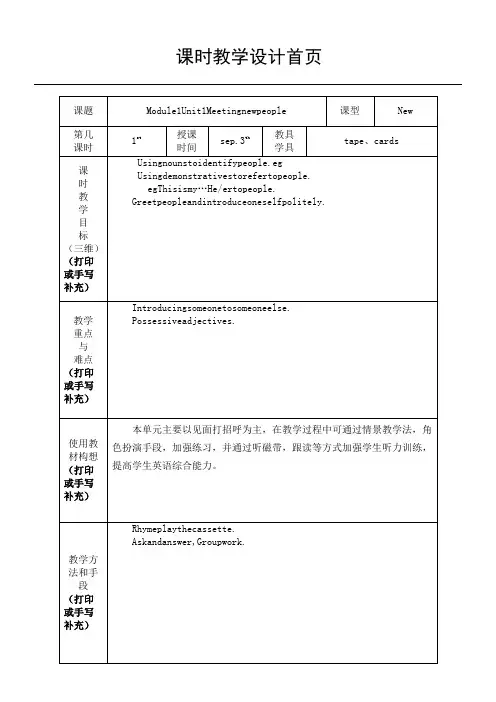
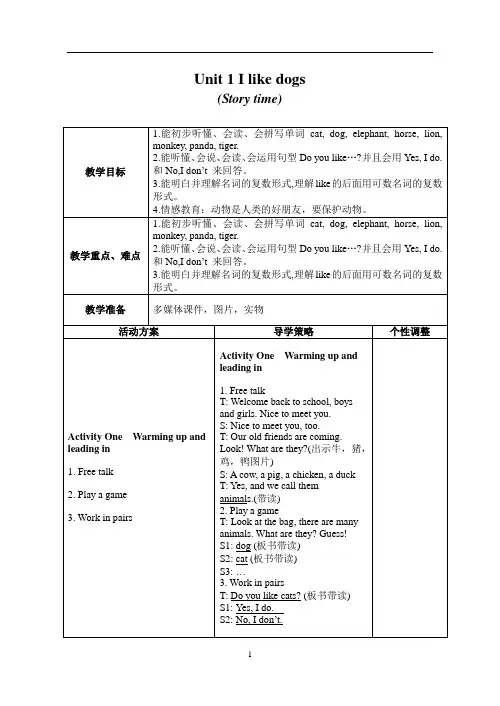
Unit 1 I like dogs (Story time)T: What animals do Yang Ling ands watch theUnit 1 I like dogs (Fun time & Cartoon time)Unit 1 I like dogs(Sound time & Rhyme time & Checkout time & Ticking time)Unit 2 Let’s make a fruit salad(Story time)2. Read and answerT: Does Yang Ling have anyUnit 2 Let’s make a fruit salad (Fun time & Cartoon time)Unit 2 Let’s make a fruit salad(Sound time & Song time & Checkout time & Ticking time)Unit 3 How many?(Story time)A:What do you have ?…. A:What do you have ?.Unit 3 How many? (Fun time & Cartoon time)Unit 3 How many?(Sound time & Rhyme time & Checkout time & Ticking time)Unit 4 I can play basketball(Story time)What are they talking about :B:2. Read and answer一、Can Wang Bing play2. Read and answerUnit 4 I can play basketball (Fun time & Cartoon time)Unit 4 I can play basketball(Sound time & Rhyme time & Checkout time & Ticking time)Unit 5 Our new home(Story time)watch the cartoon, then match. Where are…?Unit 5 Our new home (Fun time & Cartoon time)Unit 5 Our new home(Sound time & Rhyme time & Checkout time & Ticking time)Unit 6 At a snack bar(Story time)snack bar /snæk/Unit 6 At a snack bar (Fun time&Cartoon time)Unit 6 At a snack bar(Sound time & Rhyme time & Checkout time & Ticking time)Unit 7 How much?(Story time)How much are the shoes? T: How much are the shoes?Unit 7 How much (Fun time & Cartoon time)Unit 8 Dolls (Story time)Unit 8 Dolls (Fun time & Cartoon time)。

牛津小学英语4Aunit1教案Unit 1 May I have …?教材简析:本单元由Read and say ,Look ,read and learn ,Ask and answer ,Work in pairs ,Read and act 及Fun house 六个部分组成。
安排了“新学期向老师要新课本”、“教师节给教师送贺卡并向老师表示祝贺”这两个语言情景,话题贴近生活,学生乐意学习。
在教学内容方面,从本单元起对部分单词和句子提出了书写要求,本单元要求能听懂、会说、会读和会拼写单词a pen ,a ruler ,a rubber ,a ball pen ,a pencil case ,a book .能听懂、会说、会读和会写句型May I have …? This …is for ….,因此,对单词的字体、书写方法、规格等方面要进行示范、指导,使学生逐步形成良好的书写习惯。
教学目的:1.能听得懂、会说、会读和会拼写单词a pen ,a ruler ,a rubber ,a ball pen ,a pencil case ,a book .2.能听懂、会说和会读日常交际用语May I come in ?Come in ,please .Yes /Sure .Here you are .Thank you .All right .Good morning .Goodbye .Here‘s a …for …Happy Teacher‘s Day !3.能听懂、会说、会读、会写句型May I have …?This …is for …..4.了辅音字母b 和c 在单词中的读音。
5.训练学生用所学英语知识做简单的调查统计。
6.能诵读歌谣A little book .教学重点:1、能听得懂、会说、会读和会拼写单词a pen ,a ruler ,arubber ,a ball pen ,a pencil case ,a book .2、能听懂、会说、会读、会写句型May I have …?This …is for …..3、训练学生动用所学英语知识做简单的调查统计。


沪教牛津版小学四年级英语教学设计目录Unit1 Meeting new peopleUnit2 Can you swimUnit3 Are you happyUnit4 Do you have any cousinsUnit5 My friendsUnit6 My parentsUnit7 At schoolUnit8 At the shopUnit9 At homeUnit10 Around my homeUnit11 ShapesUnit12 Weather备课人:章金芝Meeting new peopleHe’s/ She’s ... (age)He / She can ...3)语法:1. 形容词性物主代词 my, her, his, your在英语中有物主代词,它可以分成名词性的和形容词性的。
形容词性物主代词相当于形容词,置于名词前,在句子中用于修饰名词,做定语,后面必须跟一个名词。
例如:This is my brother. His name is Tom. 这是我的哥哥。
他叫汤姆。
形容词性物主代词有人称和数的变化,单数形式:my(我的),your(你的),his /her/its(他的、她的、它的)。
复数形式:our(我们的),your(你们的),their(他们的)。
练习:1. This is my book. are over there.A. YourB. YoursC. YouD. Mine2. Whose pen is it? It’s .A. herB. hersC. sheD. his3. __ bag is new and __ is new, too.A. Our, heB. Ours, hisC. My, hisD. My, her4. This room is ours, and that one is __.A. theyB. themC. theirsD. their5. Whose pencils are there? They’re __.A. myB. meC. mineD. our6. Is the new watch __? Yes, it’s __.A. you, meB. yours, mineC. your, myD. your, mine7. Whose shoes are these? They are __.A. meB. mineC. myD. I8. She is a student , __ name is Han Mei.A. itsB. herC. hersD. his9. It’s a dog. I don’t know __ name.A. its’B. itsC. itD. it’s10. This ruler isn’t mine. I think it is __.A. heB. himC. hisD. her11.__ schoolbag is beautiful. But __ is more beautiful.A. Jims, myB. Jim’s, mineC. Jim’s, meD. Jims’, I12. __ am a boy and __ is a girl.A. My, sheB. I, herC. I, sheD. Mine, she13.I like __ new dress.A. SheB. herC. hersD. his14.I often help __ mother do __ housework(家务活)。
牛津小学英语四年级4A第1-2单元教案集体备课Unit1Thefirstperiod教学内容Unit1ayIhave……?教学目标知识和能力掌握单词、词组copyboo,ein,sure,have,能听懂、会说、会读日常交际用语:ayIein?ayIhave…?Sure.Hereyouare过程和方法启发式教学自主合作探究情感态度与价值观培养学生对生活的热爱和对英语学习的兴趣教学重难点教学重点:单词的四会掌握教学难点:初步了解掌握句型:ayIhave…for…?This…isfor…教学准备图片、录音机、学生准备的文具教学过程学生活动诊断与调整Step1aringupT:Hello,boysandgirls.Nicetoeetyou.T:ell,let’sstartourEnglishclass,o?Step2PresentationandPractiseT:First,let’splayaguessinggae.“hat’sinybag?”T:Ihave…我有…….Have,have,…T:Loo,Ihavearuler.Ihaveapencil.T:同学们,你们想得到这些文具吗?如果想要,请用英语说ayIhavea…?我可以要一个…吗?T:我想要一本书吗,可以说ayIhaveaboo?我想要一支圆珠笔吗?可以说ayIhaveaballpen?我想要一支钢笔吗?可以说ayIhaveapen?T:yes.Thisrulerisforyou.同学们,你们听到issLiu是怎样回答的吗?T:yes,thisrulerisforyou.This…isforyou.这个…给你。
Readaftere,please.T:请你利用身边的文具编一组对话,Pleaseorinpairs.A:ayIhave…?B:yes,this…isfor…Step3ReadandsaT:今天,issLiu想介绍两位新朋友,TheyareSuyangandSuHai.Theyaretins.ThisisSuyangandth isisSuHai.Let’ssay“Hello”tothe.ell,boysandgirls.Let’slistentothetapecarefullyandanser.Question:苏海向issLi要了什么?T:yes,sheassissLiforcopyboos.带读Acopyboo.T:Hoanycopyboosdoesshehaveno?T:yes.Shehasto.oneisforherselfandoneisforSuyang.Question:她是怎样替Suyang要抄写本的呢?T:yes.Shesays,“ayIhaveacopybooforSuyang?”带读issLi:Sure.Hereyouare.带读T:Sure.Hereyouare.T:同学们在录音中听到,issLi在办公,SuHai想进办公室,她是怎样说的?yes,ayIein?yes,ein,please.Listenandrepeat.Shothepictures,readafterthetapeandtheteacher.Step3consonlidationorinpairstopractisethisdialogue,Actoutthedialogueinroles.Retellthedialogue.Step4Assignhoeor1.copeneordsandnesentencepatterns .ListentothepartAofUnit1Ss:…Ss:…Ss:跟读Ss:Ihavearubber.Ihaveapen…Ss:跟读S1:ayIhavearuler?Ss:yes,thisrulerisforyou.Ss:Practiceiththeirparnter s.Ss:sheassissLiforcopyboos.Ss:跟读Ss:…Ss:跟读Ss:ayIhaveacopybooforLiuTao?Ss:…板书设计:Unit1ayIhave……?partA挂图copybooein,A:ayIhave…?surehave B:yes,this…isfor…Unit1Thesecondperiod教学内容Unit1ayIhave……?教学目标知识和能力能听、说、读、写单词apen,aballpen,apencil,aboo.能熟练运用和正确书写句型ayIhave…?yes/Sure.Hereyouare.This…isfor……过程和方法任务型教学小组合作学习情感态度与价值观培养学生的团结精神和合作意识教学重难点教学重点:单词的四会和句型的掌握教学难点:句型的正确书写和熟练默写教学准备图片、录音机、学生准备的文具、partc挂图教学过程学生活动诊断与调整Step1aringup.Singasong:Hello..Greetings:ayIein?yes,ein,please.Step2Revision学生用自己的实物表演Readandsay中的对话。
Module 1 Getting to know youUnit 3 What are you?The Second PeriodLanguage focus:Knowledge objective:ing nouns to identify people (doctor, waiter…)2.Asking ‘Wh-‘ questions to find out a person’s identity.(What’s he/she?)3.Saying the sounds. ’ph-’ ‘wh-‘.Skill objective:Read the words correctly.Emotion objective:了解不同职业的作用,明白职业不分贵贱。
Materials:Student’s Book 4A page 9MediaTeaching procedures:I. Pre-task preparation:A. Read a rhyme.B. Ask & answersII. While-task procedureWords: doctor, dentist, nurseShow the picture of the hospital.What can you see in the hospital?Doctor, dentist, nurseRead the words.Dog—doctorDesk-dentistPurse-nurseTalk about the doctor, nurse, dentist.Doctor, doctor, a clever doctor.Nurse, nurse, clean nurses.Dentist, dentist, brave dentists.What can they do?Words: shop assistant, waiter, waitress, bus-driverYou want to buy something. Who can help you?You’re hungry. You want to eat something. Who can help you?Read the words.waiter, waitress.—actor, actressC. Getting to know the names of jobsfire+man---firemanpolice+man/woman---policeman/policewomanambulance+man---ambulance manshop+assistant---shop assistantbus+driver---bus-driverpost+man---postman(课中有不少表示职业的名词,其中一些是复合词)D. Say something about them.1). Write the following three groups of words on the board:bus-driver helps sick peoplepoliceman drives a busdentist looks after criminalsdoctor arrests peoples’ teeth2). Get the learners to make sentences with words from the three groups , for example:( Have a discussion in groups of four)A bus-driver drives a bus.Ask and answer.What is your father?...(Learn the words: worker, clerk, engineer, manager)III. Post-task activitiesQuick response.(Look at the pictures.) What’s he/she?Do a survey.Talk about your family.Learn the sounds.Ph/f/ photo, telephone, Philip, phone.Wh/w/ what , where, white, whale, whichIV. HomeworkListen and read on page 9.Copy the words and sentences.Talk about the professions with your friends.。
《牛津小学英语4A》Unit 1第一课时表格式教案2篇Teaching plan of unit 1 in unit 1 of Oxford pri mary school English 4A《牛津小学英语4A》Unit 1第一课时表格式教案2篇前言:小泰温馨提醒,英语作为在许多国际组织或者会议上都是必需语言,几乎所有学校选择英语作为其主要或唯一的外语必修课。
英语教学涉及多种专业理论知识,包括语言学、第二语言习得、词汇学、句法学、文体学、语料库理论、认知心理学等内容。
本教案根据英语课程标准的要求和针对教学对象是小学生群体的特点,将教学诸要素有序安排,确定合适的教学方案的设想和计划、并以启迪发展学生智力为根本目的。
便于学习和使用,本文下载后内容可随意修改调整及打印。
本文简要目录如下:【下载该文档后使用Word打开,按住键盘Ctrl键且鼠标单击目录内容即可跳转到对应篇章】1、篇章1:《牛津小学英语4A》Unit 1第一课时表格式教案2、篇章2:牛津小学英语4A Unit 6第一课时教学设计篇章1:《牛津小学英语4A》Unit 1第一课时表格式教案课题unit 1 may i have…?第一课时(新授课)课时教学目标1、认知:(1)能正确听说读写单词 a pen, a ball pen,a pencil, a book。
(2)能正确听说读单词a copybook, a ruler, a rubber, a pencil case, a bookmark, a notebook, a school bag。
(3)能正确听说读写句型may i have…?(4)能正确听说读日常交际用语yes./sure. here you are. thank you.2、能力:培养学生在词语与相应事物之间建立联想的能力。
3、情感:培养学生积极参与课堂教学。
教学重难点四会单词、句型的朗读和书写教学准备课件、文具、袋子教学方法情境教学、实物教学、朗读教学、游戏教学师生互动二次复备step 1: warming up1.introduction2.chant3.free talk and revisiont: what’s this on your desk/ in your desk/ in your pencil case…?s: it’s a pen/ruler/rubber/ knife/book/copybook/school bag/ crayon.step 2: presentation and practice1.learn new words and sentencesa. learn “a pen”t: boys and girls, today i am very happy, because i have a new bag. look! it’s very ni ce. i like it very much. but what’s in my bag? who can guess?s guess.t: let me see. yes, / no, there is a pen. (read and spell)b. learn the sentencet: may i have a pen?(t带读句型并做替换练习,用a ruler, a rubber, a pencil case, a copybook, a school bag 注意may, i, have的发音)s make sentences. t: yes. / sure. here you are. s read.c. learn “a ball pen”t: boys and girls, look. is it a pen? no, it isn’t. it’s a ball pen. (read and spell)t: may i have a ball pen? s: sure. / yes. here you are.(read the sentences.)d. learn “a pencil” “a pencil case”t: may i have a pencil? s: yes. /sure. here you are.t: thank you. (read and spell)t: may i have a pencil box/ case?s: yes. /sure. here you are. t: thank you.师生互动二次复备(read the word 比较pencil box与pencil case)e. learn “a book”t: may i have a book? s: yes. /sure. here you are.t: thank you. (read and spell)f. learn “a bookmark”t: look, what’s this? it’s a bookmark. (read the word)g. learn “notebook”t: look, is it a book? is it a storybook? is it a copybook? it’s a notebook. (比较copybook与notebook)(read the word)2.play a game: what’s missing?3.practiset: boys and girls, you are very clever. you have learned so many new words. what voice? (嘘,假装在听包说悄悄话,并不时点头作高兴状) she tells me that she likes you very much. if you can use the sentence “may i have…?” she will give you what you want.step 3: consolidation1.ask and answer(part c)2.play a game: 在文具店t: now we are in the stationery shop. i’m the shop assistant. who’d like to be the customer?s1: may i have…?t: what colour? / what about…?s1: oh, i’d like … t: sure. / yes. here you are.s1: thank you. how much is it? t: …yuan, please.s&s作业1.copy the new words and sentences.2.listen to the tape and repeat part b three times.3.write the dialogues of part c in books教学板书内容单词unit1 may i have…?may i have…?yes. / sure. here you are.教学随感《牛津小学英语4a》unit 1第一课时表格式教案篇章2:牛津小学英语4A Unit 6第一课时教学设计【按住Ctrl键点此返回目录】【课题】:《whose gloves?》【教材简解】:本课时选自《牛津小学英语4a》中的unit 6。